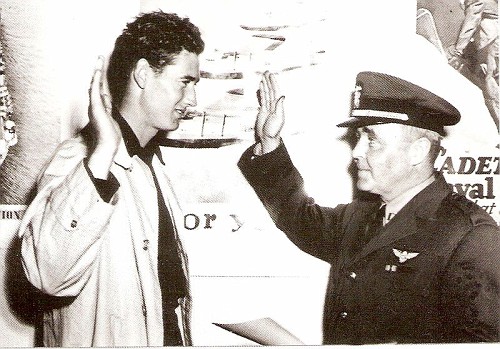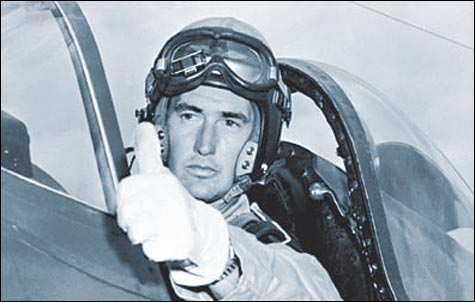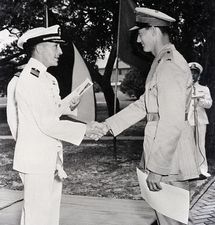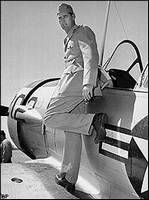Theodore Samuel "Ted" Williams (August 30, 1918 – July 5, 2002) was an American professional baseball player and manager. He played his entire 21-year Major League Baseball career as the left fielder for the Boston Red Sox (1939–1942 and 1946–1960). Williams was a two-time American League  Most Valuable Player (MVP) winner, led the league in batting six times, and won the Triple Crown twice. A nineteen-time All-Star, he had a career batting average of .344, with 521 home runs, and was inducted into the Baseball Hall of Fame in 1966. Williams recorded a hit 34 percent of the time; he reached base an astounding 48 percent of the time. Most Valuable Player (MVP) winner, led the league in batting six times, and won the Triple Crown twice. A nineteen-time All-Star, he had a career batting average of .344, with 521 home runs, and was inducted into the Baseball Hall of Fame in 1966. Williams recorded a hit 34 percent of the time; he reached base an astounding 48 percent of the time. Williams was the last player in Major League Baseball to bat over .400 in a single season (.406 in 1941). Williams holds the highest career batting average of anyone with 500 or more home runs. His career year was 1941, when he hit .406 with 37 HR, 120 RBI, and 135 runs scored. His .551 on base percentage set a record that stood for 61 years. Nicknamed "The Kid", "The Splendid Splinter", "Teddy Ballgame", "The Thumper" and, because of his hitting prowess, "The Greatest Hitter Who Ever Lived", Williams's career was twice interrupted by service as a U.S. Marine Corps fighter-bomber pilot. An avid sport fisherman, he hosted a television program about fishing, and he was inducted into the IGFA Fishing Hall of Fame. |
Williams served as a naval aviator (a U.S. Marine Corps pilot) during World War II and the Korean War. He had been classified 3-A by Selective Service prior to  the war, a dependency deferment because he was his mother's sole means of financial support. When his classification was changed to (1-A) following the American entry into World War II, Williams appealed to his local draft board. The draft board ruled that his draft status should not have been changed. He made a public statement that once he had built up his mother's trust fund, he intended to enlist. Even so, criticism in the media, including withdrawal of an endorsement contract by Quaker Oats, resulted in his enlistment in the Marine Corps on May 22, 1942. the war, a dependency deferment because he was his mother's sole means of financial support. When his classification was changed to (1-A) following the American entry into World War II, Williams appealed to his local draft board. The draft board ruled that his draft status should not have been changed. He made a public statement that once he had built up his mother's trust fund, he intended to enlist. Even so, criticism in the media, including withdrawal of an endorsement contract by Quaker Oats, resulted in his enlistment in the Marine Corps on May 22, 1942. Williams could have received an easy assignment and played baseball for the Navy or the Marine Corps. Instead, he decided to defend his country and he joined the V-5 program to become a Naval aviator. Williams was first sent to the Navy's Preliminary Ground School at Amherst College for six months of academic instruction in various subjects including math and navigation, where he achieved a 3.85 grade point average. academic instruction in various subjects including math and navigation, where he achieved a 3.85 grade point average. Williams's Red Sox teammate, Johnny Pesky, who went into the same aviation training program, said this about Williams: "He mastered intricate problems in fifteen minutes which took the average cadet an hour, and half of the other cadets there were college grads." Pesky again described Williams's acumen in the advance training for which Pesky personally did not qualify: "I heard Ted literally tore the sleeve target to shreds with his angle dives. He'd shoot from wingovers, zooms, and barrel rolls, and after a few passes the sleeve was ribbons. At any rate, I know he broke the all-time record for hits." Ted went to Jacksonville for a course in aerial gunnery, the combat pilot's payoff test, and broke all the records in reflexes, coordination, and visual-reaction time. "From what I heard. Ted could make a plane and its six 'pianos' (machine guns) play like a symphony orchestra," Pesky says. "From what they said, his reflexes, coordination, and visual reaction made him a built-in part of the machine." Williams completed pre-flight training in Athens, Georgia, his primary training at NAS Bunker Hill, Indiana, and his advanced flight training at NAS Pensacola.  He received his pilot's wings and his commission in the U.S. Marine Corps on May 2, 1944. He received his pilot's wings and his commission in the U.S. Marine Corps on May 2, 1944. Williams served as a flight instructor at the Naval Air Station Pensacola teaching young pilots to fly the complicated F4U Corsair fighter plane. Williams was in Pearl Harbor awaiting orders to join the Fleet in the Western Pacific when the War in the Pacific ended. He finished the war in Hawaii, and then he was released from active duty on January 12, 1946, but he did remain in the Marine Forces Reserves. On May 1, 1952, at the age of 34, Williams was recalled to active duty for service in the Korean War. He had not flown any aircraft for about eight years but he turned down all offers to sit out the war in comfort as a member of a service baseball team. Nevertheless, Williams was somewhat resentful of being called up, which he admitted years later, particularly regarding the Navy's odd policy of calling up Inactive Reservists rather than members of the Active Reserve. After eight weeks of refresher flight training and qualification in the F9F Panther jet fighter at the Marine Corps Air Station Cherry Point, North Carolina, Williams was assigned to VMF-311, Marine Aircraft Group 33 (MAG-33), based at the K-3 airfield in Pohang, South Korea. On February 16, 1953, Williams was part of a 35-plane air raid against a tank and infantry training school just south of Pyongyang, North Korea. During the mission a piece of flak knocked out his hydraulics and electrical systems, causing Williams to have to "limp" his plane back to K-13, a U.S. Air Force airfield close to the front lines. For his actions of this day he was awarded the Air Medal. Williams stayed on K-13 for several days while his plane was being repaired. Because he was so popular, GIs and airmen from all around the base came to see him and his plane. After it was repaired, Williams flew his plane back to his Marine Corps airfield. In Korea, Williams flew 39 combat missions before being withdrawn from flight status in June 1953 after a hospitalization for pneumonia. This resulted in the discovery of an inner ear infection that disqualified him from flight status. During the Korean War, Williams also served in the same Marine Corps unit with John Glenn, and in the last half of his missions, Williams was flying as Glenn's wingman. While these absences in the Marine Corps, which took almost five years out of the heart of a great baseball career, significantly limited his career totals, he never publicly complained about the time devoted to service in the Marine Corps. His biographer Leigh Montville argued that Williams was not happy about being pressed into service in South Korea, but he did what he thought was his patriotic duty. about being pressed into service in South Korea, but he did what he thought was his patriotic duty. Williams had a strong respect for General Douglas MacArthur, referring to him as his "idol". For Williams' fortieth birthday, MacArthur sent him an oil painting of himself with the inscription "To Ted Williams - not only America's greatest baseball player, but a great American who served his country. Your friend, Douglas MacArthur. General U.S. Army." In his last years, Williams suffered from cardiomyopathy. He had a pacemaker implanted in November 2000 and he underwent open-heart surgery in January 2001. After suffering a series of strokes and congestive heart failure, he died of cardiac arrest at the age of 83 in Citrus Hills, Florida, on July 5, 2002. |



























